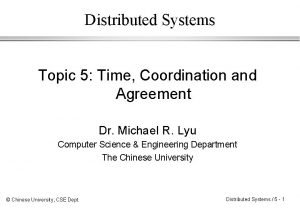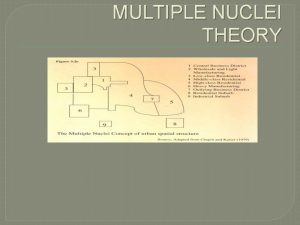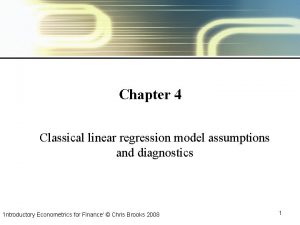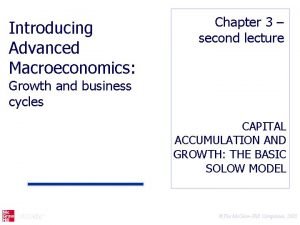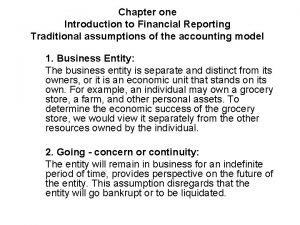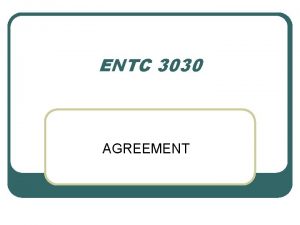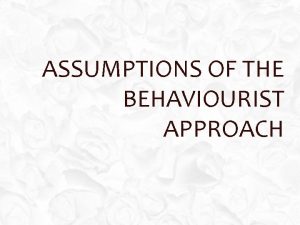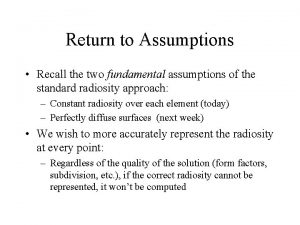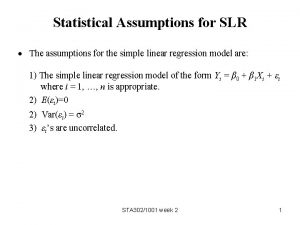Coordination and Agreement 1 Failure model z Assumptions

























- Slides: 25

Coordination and Agreement 1


Failure model z Assumptions: Independent processes, reliable channels, no Byzantine errors. z Failure detector: y. May be unreliable (yield “Unsupected” or “Suspected”). y. May be reliable (yield “Unsuspected” or “Failed”). 3

Distributed mutual exclusion z Situation: A number of processes want to access some shared resource. z Problem: Prevent interference, maintain consistency; critical section. z Examples: y. Shared files. y. Car park monitoring. 4

Distributed mutual exclusion – central server algorithm 5

Distributed mutual exclusion – ring-based algorithm 6

Distributed mutual exclusion – time-stamp based algorithm On initialization state : = RELEASED; To enter the section state : = WANTED; Multicast request to all processes; request processing deferred here T : = request’s timestamp; Wait until (number of replies received = (N – 1)); state : = HELD; On receipt of a request <Ti, pi> at pj (i ≠ j) if (state = HELD or (state = WANTED and (T, pj) < (Ti, pi))) then queue request from pi without replying; else reply immediately to pi; end if To exit the critical section state : = RELEASED; reply to any queued requests; 7

Distributed mutual exclusion – time-stamp based algorithm example 41 p 3 Reply 1 34 Reply 41 34 p Reply 34 2 8

Maekawa’s voting algorithm -Candidate ? ? -Candidate – must collect Sufficient votes to enter - Casting their votes to only one Candidate. 9

10

Elections z Situation: A unique process to play a particular role among a set of processes must be chosen. z Problem: All processes must agree on the choice. z Examples: y. Central server algorithm for mutual exclusion. y. Coordinator process in Berkeley algorithm for internal clock synchronization. 11

Elections – basics z Protocol: y A process may call an election. y Any process is either participant or non-participant in an election. y The elected process should be chosen as the one with largest identifier. z Correctness criteria: y Safety. y Liveness. z Performance measures: y Bandwidth. y Turn-around time. 12

Elections – ring-based election algorithm z N processes arranged in a ring; a coordinator must be elected; no failures occur. z Initially, each process is non-participant. z Some process pi sends an election message, elctn(i). z When a process pr receives a message elctn(i): y If r<i then forward elctn(i); participant(pr) : = true; endif; y If (r>i and not(participant(pr))) then x forward (elctn(r)); participant(pr) : = true; endif; y If (r>i and participant(pr)) then skip (* do not forward *); endif; y If r=i then participant(pr) : = false; send(elctd(r)); endif; z When a process pr receives an elected message, elctd(c): y participant(pr) : = false; elected(r) : = c; y if r=c then skip (* do not forward *) else forward (elctd(c)); endif; 13

Elections – ring-based election algorithm example Note: The election was started by process 17. The highest process identifier encountered so far is 24. Participant processes are shown darkened 14

Elections – bully election algorithm example 15

Multicast communication z The aim is for each of a group of processes to receive copies of the messages sent to the group. z A process issues only one multicast operation to send a message to a group of processes instead of issuing multiple send operations. z Multicast operations may provide: y. Delivery guarantees. y. Efficiency. 16

Multicast communication – basics z Failure model: Reliable channels, processes may crash. z Processes are member of groups (open or closed). z Operations: ymulticast(g, m). ydeliver(m). 17

Multicast communication – basic multicast z B-multicast based on a reliable one-to-one send operation: y. To B-multicast(g, m), for each p in g, send(p, m). y. On receive(m) at p, B-deliver(m) at p. z May be implemented using threads to perform the send operations concurrently. z May suffer from the ack-implosion problem. 18

Multicast communication – reliable multicast z Integrity: A correct process p delivers a message m at most once. Furthermore p in group(m) and m was supplied to a multicast operation by sender(m). z Validity: If a correct process multicasts message m, then it will eventually deliver m (assumption: closed groups). z Agreement: If a correct process delivers message m, then all other correct processes in group(m) will eventually deliver(m). 19

Multicast communication – reliable multicast algorithm 20

Multicast communication – orderings; bulletin board example (self study) Bulletin board: os. interesting Item From Subject 23 A. Hanlon Mach 24 G. Joseph Microkernels 25 A. Hanlon Re: Microkernels 26 T. L’Heureux RPC performance 27 M. Walker Re: Mach end 21

Multicast communication – ordering relations (self study) z FIFO ordering: If a correct process issues multicast(g, m) and then multicast(g, m’), then every correct process that delivers m’ will deliver m before m’. z Causal ordering: If multicast(g, m) -> multicast(g, m’), then any correct process that delivers m’ will deliver m before m’. z Total ordering: If a correct process delivers m before it delivers m’, then any other correct process that delivers m’ will deliver m before m’. z Hybrid ordering relations exist. 22

Multicast communication – ordering examples (self study) Notice the consistent ordering of totally ordered messages T 1 and T 2, the FIFO-related messages F 1 and F 2 and the causally related messages C 1 and C 3 – and the otherwise arbitrary delivery ordering of messages. 23

Multicast communication – bulletin board example revisited (self study) Bulletin board: os. interesting Item From Subject 23 A. Hanlon Mach 24 G. Joseph Microkernels 25 A. Hanlon Re: Microkernels 26 T. L’Heureux RPC performance 27 M. Walker Re: Mach end 24

Summary z Failures and failure detection. z Distributed mutual exclusion: y. Central-server algorithm. y. Ring-based algorithm. y. Time-stamp based algorithm. z Elections: y. Ring-based algorithm. z Multicast communication y. Basic multicast. y. Reliable multicast. y. Ordering semantics. 25
 Ventricular escape rhythm
Ventricular escape rhythm Failure to sense vs failure to capture
Failure to sense vs failure to capture Cup and cone fracture ductile or brittle
Cup and cone fracture ductile or brittle Assumptions about coordination
Assumptions about coordination Coordination and agreement in distributed system
Coordination and agreement in distributed system Slidetodoc.com
Slidetodoc.com Positive agreement
Positive agreement Chicago multiple nuclei model
Chicago multiple nuclei model Similarities between concentric and sector model
Similarities between concentric and sector model Classical linear regression assumptions
Classical linear regression assumptions Assumptions of capm model
Assumptions of capm model Von thunens model
Von thunens model Assumptions of solow growth model
Assumptions of solow growth model Traditional assumptions of the accounting model
Traditional assumptions of the accounting model Eoq model with planned shortages
Eoq model with planned shortages Assumptions of marris model
Assumptions of marris model Cash management objectives
Cash management objectives Von thunens model
Von thunens model Von thunen's model
Von thunen's model Annotated model grant agreement
Annotated model grant agreement Model grant agreement
Model grant agreement Model grant agreement
Model grant agreement Model grant agreement
Model grant agreement Model grant agreement
Model grant agreement System requirements document
System requirements document Assumptions and dependencies example
Assumptions and dependencies example




